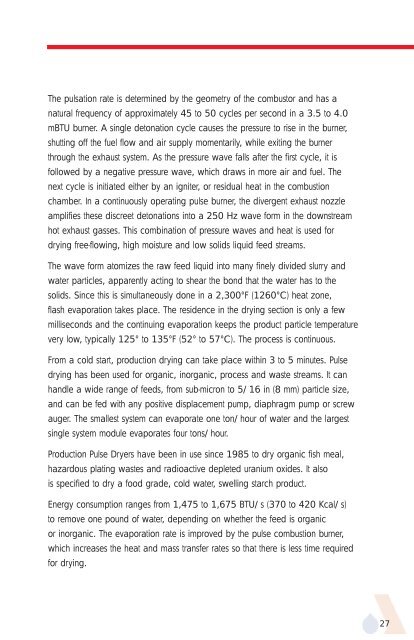APV Dryer Handbook - Umbc
APV Dryer Handbook - Umbc
APV Dryer Handbook - Umbc
Create successful ePaper yourself
Turn your PDF publications into a flip-book with our unique Google optimized e-Paper software.
The pulsation rate is determined by the geometry of the combustor and has a<br />
natural frequency of approximately 45 to 50 cycles per second in a 3.5 to 4.0<br />
mBTU burner. A single detonation cycle causes the pressure to rise in the burner,<br />
shutting off the fuel flow and air supply momentarily, while exiting the burner<br />
through the exhaust system. As the pressure wave falls after the first cycle, it is<br />
followed by a negative pressure wave, which draws in more air and fuel. The<br />
next cycle is initiated either by an igniter, or residual heat in the combustion<br />
chamber. In a continuously operating pulse burner, the divergent exhaust nozzle<br />
amplifies these discreet detonations into a 250 Hz wave form in the downstream<br />
hot exhaust gasses. This combination of pressure waves and heat is used for<br />
drying free-flowing, high moisture and low solids liquid feed streams.<br />
The wave form atomizes the raw feed liquid into many finely divided slurry and<br />
water particles, apparently acting to shear the bond that the water has to the<br />
solids. Since this is simultaneously done in a 2,300°F (1260°C) heat zone,<br />
flash evaporation takes place. The residence in the drying section is only a few<br />
milliseconds and the continuing evaporation keeps the product particle temperature<br />
very low, typically 125° to 135°F (52° to 57°C). The process is continuous.<br />
From a cold start, production drying can take place within 3 to 5 minutes. Pulse<br />
drying has been used for organic, inorganic, process and waste streams. It can<br />
handle a wide range of feeds, from sub-micron to 5/16 in (8 mm) particle size,<br />
and can be fed with any positive displacement pump, diaphragm pump or screw<br />
auger. The smallest system can evaporate one ton/hour of water and the largest<br />
single system module evaporates four tons/hour.<br />
Production Pulse <strong>Dryer</strong>s have been in use since 1985 to dry organic fish meal,<br />
hazardous plating wastes and radioactive depleted uranium oxides. It also<br />
is specified to dry a food grade, cold water, swelling starch product.<br />
Energy consumption ranges from 1,475 to 1,675 BTU/s (370 to 420 Kcal/s)<br />
to remove one pound of water, depending on whether the feed is organic<br />
or inorganic. The evaporation rate is improved by the pulse combustion burner,<br />
which increases the heat and mass transfer rates so that there is less time required<br />
for drying.<br />
27











